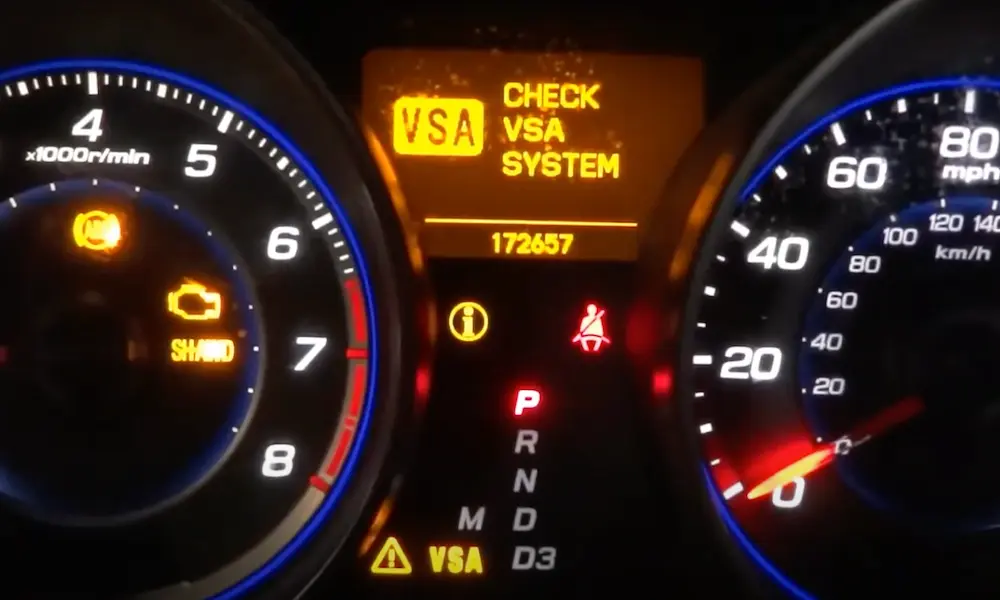Facing transmission problems with your Acura MDX can feel overwhelming, especially when you’re driving a luxury SUV that promises performance. Common issues like fluid leaks, shifting troubles, and torque converter failure can affect your vehicle’s reliability. Don’t worry, though—you can find solutions to these issues, which save you time and money. By learning about these problems, you can make informed decisions and keep your MDX running smoothly.
Common Transmission Problems in Acura MDX
The Acura MDX can experience several transmission problems that you might encounter. Recognizing these issues early can save time and avoid costly repairs. Below are some common signs and symptoms to watch out for.
Warning Light Indicators
Your Acura MDX’s dashboard may display warning lights, signaling potential transmission issues. One of the most common is the “Check Engine” light, which can indicate a variety of problems, including those related to the transmission system. When this light appears, it’s crucial to have your vehicle inspected to determine the cause.
Ignoring these indicators can lead to severe damage and expensive repairs. The transmission system light might also come on, alerting you to specific transmission-related issues like solenoid failure. If such lights appear, ensure you address the underlying problems quickly. Transmission system problem light alerts in an Acura MDX can indicate various issues, so professional help is advisable for a thorough diagnosis.
Slipping Gears and Rough Shifting
Slipping gears and rough shifting in the Acura MDX are common problems that might affect your driving experience. When gears slip, your car can unexpectedly change speeds or fail to stay in gear, making driving unsafe. Rough shifting might also cause jerky and uncomfortable movements when changing gears.
These issues might occur due to worn-out transmission bands, low transmission fluid, or problems with the torque converter. Ensuring adequate transmission fluid levels and getting regular maintenance checks are essential to prevent these problems. Address slipping gears promptly, as they can lead to more significant issues or complete transmission failure over time. Rough shifting and gear slipping are critical issues to monitor.
Strange and Unusual Noises
Strange noises, like grinding or whining, coming from your Acura MDX can indicate transmission problems. These sounds often suggest issues such as worn gears, damaged bearings, or other internal problems. Paying attention to these noises can prevent further damage.
When you hear unusual sounds, it’s a good idea to have a professional inspect your vehicle. They can diagnose the exact cause of the noise and recommend necessary repairs. Delaying repairs can worsen the problem, leading to more serious damage and higher repair costs. Unusual noises can be a crucial indicator of underlying transmission issues, necessitating prompt attention.
Fluid Leaks and Transmission Fluid Issues
Fluid leaks and issues with transmission fluid can lead to significant problems in your Acura MDX. Transmission fluid lubricates, cools, and provides the necessary force to engage gears. If you notice red or brown spots under your vehicle, it indicates a potential transmission fluid leak.
Low fluid levels can lead to overheating, slipping gears, and general transmission deterioration. Ensure regular checks of your fluid levels to maintain proper functioning. If you suspect a leak, have it addressed quickly to prevent more extensive issues. Fluid leaks are a common concern that can affect many parts of the transmission system.
Model-Specific Acura MDX Transmission Challenges
The Acura MDX has had its share of transmission challenges over the years. You’ll find that certain model years face unique issues. It’s essential to understand these problems to better maintain your vehicle and avoid costly repairs.
2013 Acura MDX Transmission Concerns
If you drive a 2013 Acura MDX, you might have noticed some specific transmission troubles. This model is known for having jerky shifting, which can be quite annoying. Many owners report a delay when shifting from park to drive. Another common issue is a clunking noise during gear changes.
Some drivers experience a significant lag in acceleration. This can be related to problems with the transmission fluid. Keeping the fluid at the correct level is crucial. Regular checks and maintenance can help prevent these issues from worsening. You might also find discussions suggesting that replacing the transmission altogether can solve these persistent problems.
2019 Acura MDX Transmission Observations
The 2019 Acura MDX seems to have fewer major transmission issues but there are still some areas to watch out for. Many drivers report a smoother ride, but some still hear unsettling noises. Clicking or popping sounds are often heard when shifting gears.
You might find that the 2019 model sometimes hesitates or lurches during acceleration. This behavior can be frustrating. Checking for updates or recalls from Acura can often provide a solution. Ensuring regular maintenance and using high-quality transmission fluid can keep your 2019 MDX running smoothly. Staying on top of these small issues will help prevent them from developing into more significant problems.
The Impact of Maintenance on Transmission Longevity
Keeping up with maintenance is crucial for your Acura MDX’s transmission reliability. Regular checks and proper fluid management help prevent costly problems. Noticing early signs of trouble can extend the life of your transmission significantly.
Regular Maintenance Schedule
Sticking to a regular maintenance routine is essential for your transmission’s health. Routine inspections help spot minor issues before they become serious problems. It’s wise to follow the schedule in your owner’s manual or consult with your mechanic for guidance. Regularly checking your transmission fluid can catch leaks early, preventing costly repairs. Keeping your transmission cool and clean helps in prolonging its life.
Proper care involves checking for warning lights, listening for unusual noises, and noting any changes in your vehicle’s performance. These small steps can improve reliability and save you money in the long run.
Transmission Fluid Change Intervals
Changing your transmission fluid at the right time is key to keeping it running smoothly. The fluid acts as a lubricant and coolant, reducing wear and preventing overheating. You should change the fluid based on the intervals suggested by Acura, usually every 30,000 to 60,000 miles.
Keeping an eye on fluid levels ensures your transmission remains efficient. Low fluid can lead to overheating and increased wear, so regular checks are vital. Clean fluid can make a significant difference in how well your Acura MDX performs.
Detecting Early Signs of Transmission Wear
Notice any unusual behavior in your transmission early to avoid major repairs. Look out for signs like hesitation when shifting gears, strange noises, or any delay in response. If you see any warning lights on your dashboard, it’s time for a checkup.
Addressing these early markers can prevent more serious issues. Regular visits to your mechanic can catch these problems before they escalate. Being proactive in maintenance helps you avoid costly repairs and extend the lifespan of your transmission.
Dealing with Transmission Failure
When your Acura MDX experiences transmission failure, it can feel overwhelming. It’s crucial to know how to diagnose the issue and understand your repair or replacement options, along with the associated costs.
Diagnosing a Complete Transmission Failure
Diagnosing transmission failure in your Acura MDX involves looking for specific symptoms. You might notice difficulty in shifting gears, strange noises, or a warning light on your dashboard. If any of these occur, a professional diagnostic test can help pinpoint the exact issue. Specialists will examine fluid levels, electrical systems, and mechanical parts to identify the problem.
You can use a diagnostic scan tool at home to check for error codes, shedding light on potential issues. If errors persist or you’re unsure, contacting a mechanic is the best course of action. Addressing the problem promptly can prevent more expensive repairs down the road.
Options for Transmission Repair and Replacement
Once you’ve confirmed a transmission failure, you need to decide between repair or replacement. For minor issues like a fluid leak or faulty sensor, a repair might suffice. Fixing these can be more cost-effective and quicker than a full replacement. On the other hand, major problems, such as a damaged torque converter or worn-out gears, could require rebuilding or replacing the transmission.
Rebuilding involves replacing only the broken parts while keeping the rest of the system intact. Complete replacement may offer more reliability but comes at a higher cost. Weighing your options and consulting with a trusted mechanic can help you make the best decision for your MDX.
Cost-Benefit Analysis of Transmission Work
Transmission issues in your Acura MDX can lead to Expensive Repairs. Understanding the costs involved and whether it’s worth fixing or selling your vehicle can help you make an informed decision.
Analyzing Repair Versus Replacement Costs
When faced with transmission trouble, you might wonder if you should repair or replace it. Minor repairs, like fixing a fluid leak or a sensor issue, typically range from $200 to $500. These repairs can be quicker and less costly, but they address smaller problems.
Major repairs, such as rebuilding the transmission, can cost more, often from $1,500 to $4,000 or more. These are necessary when your transmission has significant wear or damage. If your transmission requires frequent repairs, the costs can add up.
Evaluate the current value of your car and how much you’re willing to invest. Consider the age and mileage of your MDX, as these factors can influence whether a repair or replacement is more economical in the long run.
When to Consider Selling Your Acura MDX
Sometimes, selling your MDX is a viable option if repairing seems too costly. This decision often depends on the age and condition of your vehicle.
If the estimated cost of repair is close to or exceeds the market value of your MDX, selling might be the better choice. Research potential buyer interest and compare the resale value to the estimated repair costs.
You should also consider the stress and time required to maintain a car with frequent transmission issues. If you’re spending more time and money on repairs, a newer vehicle might offer peace of mind and reliability.














